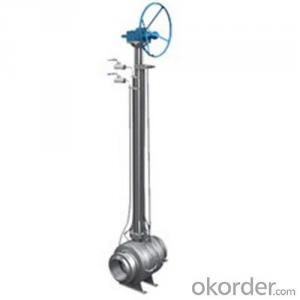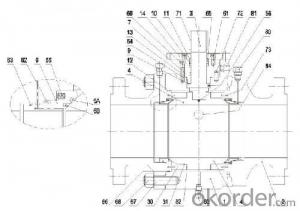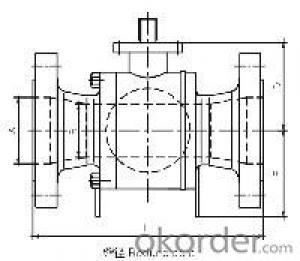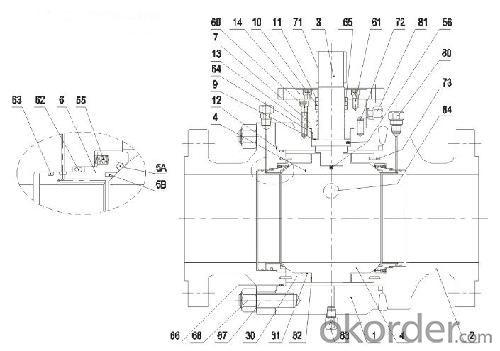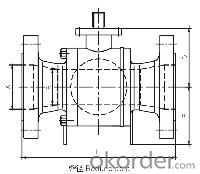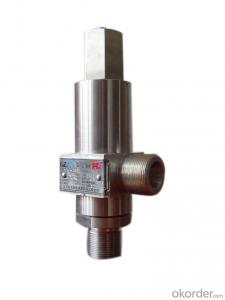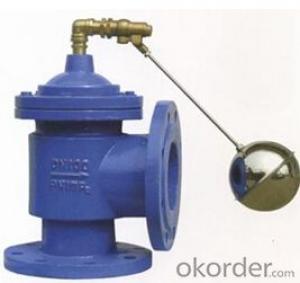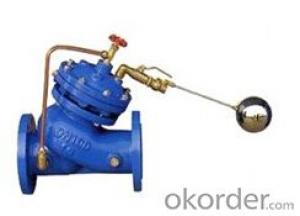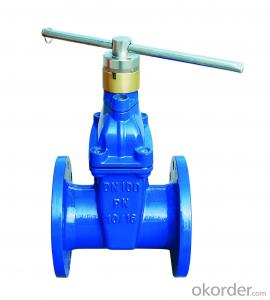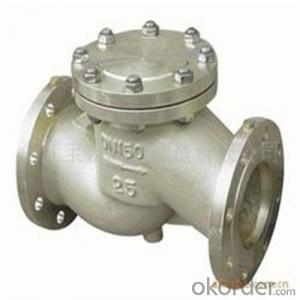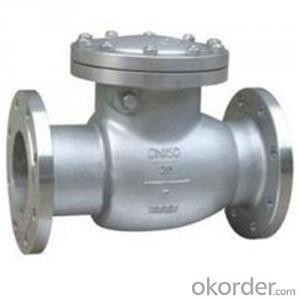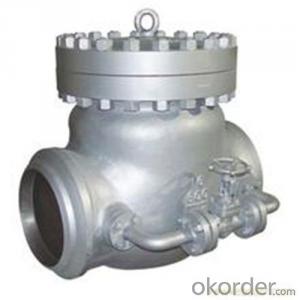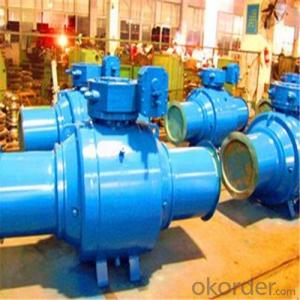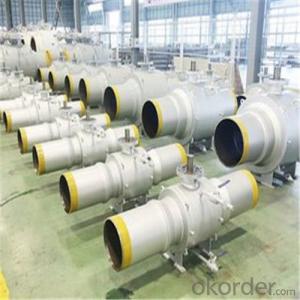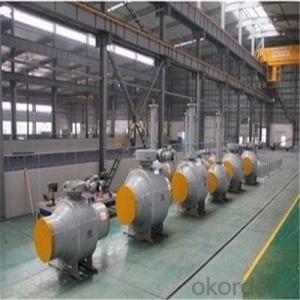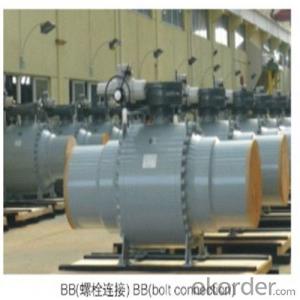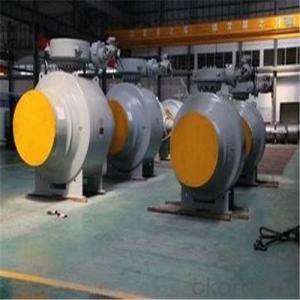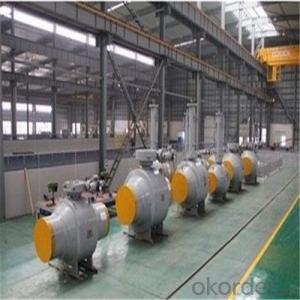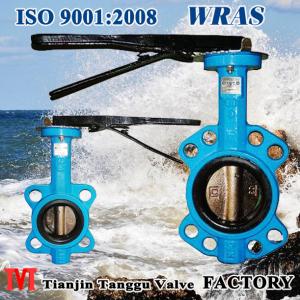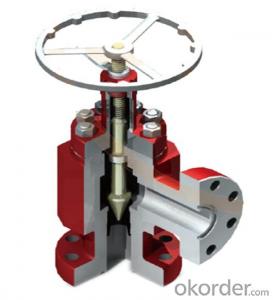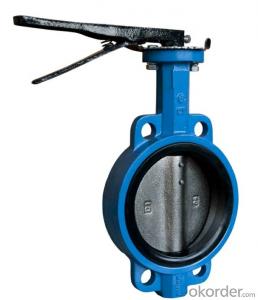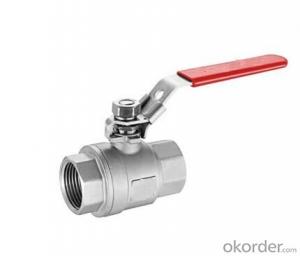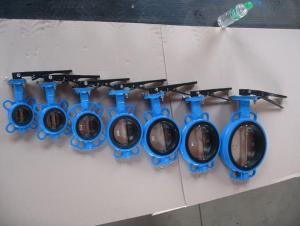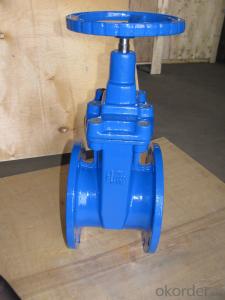Pipeline Ball Valve-Reduced Bore High-Performance DN 6 inch
- Loading Port:
- Shanghai
- Payment Terms:
- TT OR LC
- Min Order Qty:
- 10 pc
- Supply Capability:
- 100 pc/month
OKorder Service Pledge
OKorder Financial Service
You Might Also Like
pipeline ball valve-reduced bore High-performance
Product Description of High-performance pipeline ball valve-reduced bore:
High-performance pipeline ball valve is Raymond(RMD)hightech products,as switch control equipment,it is mainly used in natural gas,oil,gas,liquefied natural gas pipeline transmission system and other industries,its anti-sulfur products containing hydrogen sulphide,impurities and high corrosion are suitable for the long-distance natural gas pipeline.
Design Features of High-performance pipeline ball valve-reduced bore:
Body of high-performance pipeline ball valve is forged structure.The connection type for body and vice-body can be BB(bolted connection)and WB(welded connection).The WB(welded connection)and the LWB(Fully-welded extended stem)structure isadopted for buried ball valves,as shown below.
High performance pipeline ball valve series has the feature of strength, high perfect sealing, maintenance-free, long life and so on. The production of this series ball valve adopts the international advanced ball valve design and manufacturing technology, selects high-quality materials in accordance with the standard selection of materials and combines with advanced materials forming forging technology. At the same time, with the years of ball valve design and manufacturing experience, the use of advanced processing and manufacturing equipment and production and processing technology, through the first-class inspection and testing equipment and instruments, perfect quality assurance management system and excellence in the production of high-performance philosophy can ensure the quality of valves. This series of valve has the performance of a high strength, defect-free forging body, excellent sealing performance, even at maximum pressure difference(full pressure),it will still be able to ensure that seal without leakage, after frequent switching action to realize a safe usage in the transportation of oil, natural gas, coal gas, and other special medium transportation pipeline.
The special structure of valve seat seal of High-performance pipeline ball valve-reduced bore:
Floating structure means seat reciprocally can move along channel direction,so as to guarantee the ball and seat are tightly sealed.
(Ⅰ)Valve seat structure suitable for different occasions and sealing requirements
Valve seat can be designed as a standard single-piston effect and specific dual piston effect,Figure1 shows single-piston effect-inletside seal;Figure2 shows Dual Piston effect-outlet-side seal;Figure3 shows special dual piston effect sealing structure
(Ⅱ)Multi-level structure of the valve seat seal
As shown in Figure4,there are two elastic O-ring in the valve seat ring-ring A and ring B.Sealing ring A spring-loaded through the valve seat so that the sealing surface of sealing ring A tightly fit with ball surface to form an initial seal.When there is pressure in the system medium,the piston force
produced by the piston force produced by the piston effect of size difference makes elastic deformation of the ring A Ershi sealing surface and ball more closely fit the surface to form a re-sealing;meanwhile,due to ring A in the medium resulted in elastic deformation under pressure so that the sealing ring B is also closely fit the surface of ball for the formation of the second stage seal.When the system medium pressure increasing,it will have an enormous pressure in the valve seat ring A and ring B,so that the two seals have a greater elastic deformation,and then the metal valve seat ring surface and the ball surface sealing together to form a third level of metal to metal seal.
(Ⅲ)The assisted valve seat sealing equipment
Based on the actual service condition,medium requirement,sealing requirement,etc.,the assisted valve sealing equipment will be considered to be necessary or not.The assisted valve sealing equipment is a one-way valve installed outside of valve body that can prevent medium leakage and can inject sealing grease into valve body by external force.When the assisted valve seat sealing equipment is required,valve seat ring shall be design and processed with injection grove and hole to connect the assisted valve seat sealing equipments.Such equipment can prevent the medium by the sealing of injection of rease.Refer to Figure5 for reference.
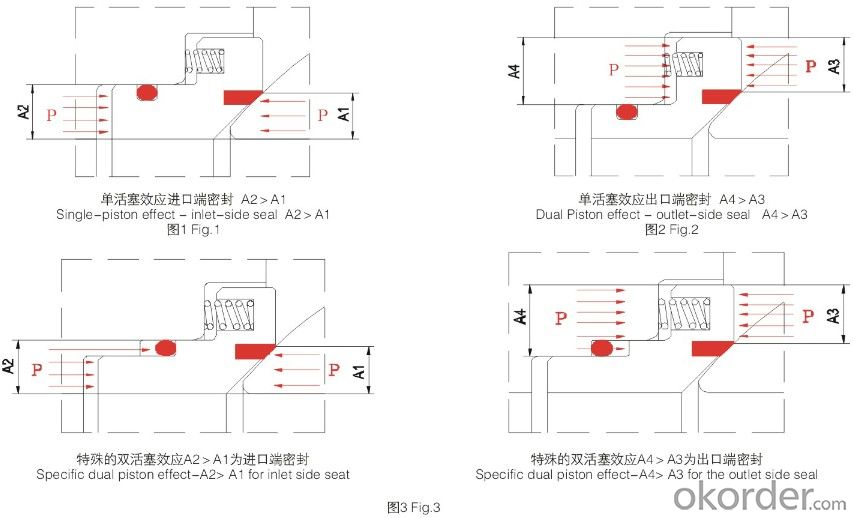
Multi-level structure of stem sealing
Figure6 shows the stem multi-level sealing by adopting"O"ring,flexible graphite and grease injection;"O"ring achieves the first level stem sealing;Replaceable flexible graphite realizes the second level sealing by the compression of packing sleeve and packing flange;And the third evel sealing is realized by installing assisted sealing injection valve to the packing box,and by designing with the injection groove and hole to connect with the stem injection valve,which can inject grease.
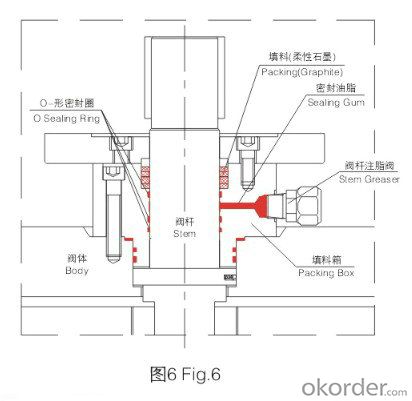
Unique and safe seat structures of High-performance pipeline ball valve-reduced bore:
Ball valve fireproof design is implementation of the API607,API6FA standards.According to service conditions and user requirements,ball valve can be designed as a fireproof structure.
(Ⅰ)Fireproof structure of seat
As shown in figure7,there is composite fireproof ring,which are combined with graphite and stainless steel wire in the seat.Once the soft ring is burnt out in case of a fire,the fireproof ring and seat ring will form a piston structure through the spring to load the valve body.That will push and closely contact the metal seal surface of the seat ring to the body surface,So as to prevent a lot of medium from leaking from the burnt place of the seat ring,and prevent the fire from expending.
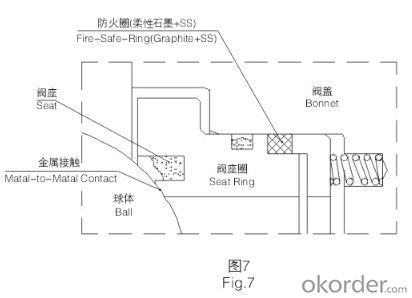
(Ⅱ)Fireproof structure(body and bonnet)
The seal gasket for bolt connecting valve body and valve bonnet,are used fireproof stainless steel wire and flexible graphite gaskets.Gasket compression load through the bolts and ultimately,ensure the valve body and valve cover between the metal to metal contact,so that the valve can with stand more high load,but also improve the fire safety of the valve.But for the full welded ball valve,the valve body and cover is welded structure,that fundamentally eliminate the possibillity of leakage of the valve housing.Even in the case of fire damage,there will be no leak.
(Ⅲ)Fireproof structure(body/packing and stem)
The body and packing connection gasket adopts fireproof stainless steel wire and flexible graphite gaskets.The stem packing adopts flexible graphite to ensure no leakage in case of fire.
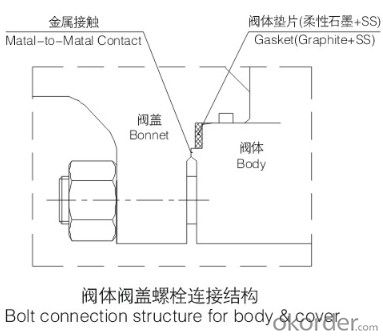
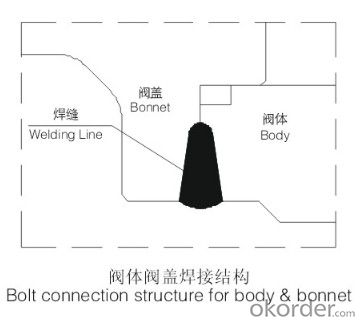
Standard of High-performance pipeline ball valve-reduced bore:
Design Standard | API 6D customize |
Connection Standard | ASME B 16.25-2007 ASME B 16.5 ASME B 31.4 ASME B 31.8 DIN GB、GB/T JB、JB/T JIS customize |
Test Standard | API 6D customize |
Face to Face | API 6D customize |
Pressure-temperature rating | ASME B 16.34-2004 customize |
Marking | MSS SP-25 customize |
FAQ of pipeline ball valve-reduced bore:
Q1:I can’t find the type of steel check valve which I need. what can I do?
The chart above only lists out some common composition of steel check valve parts.We may provide other different parts material composition according to the customer's request or the actual valve working condition.
Q2:Which certification do your products pass?
Our products are in accordance with ISO 9001、ISO 14001、API 6A、API 6D、TS CE、API607/6FA/BS6755.
Q3:How can I place an order?
The only one thing you should do is to tell us the sepecification about type 、quantity and mode of transportation, then we will send you quotation within 24 hours.
- Q: what would happen if valve was not adjusted right? and please explain
- it could make a hole in your piston
- Q: Tryin to figure out how many valves a 1992 vx has. 16 or 8?
- it has 16 valves but less horse power than a regular Civic. This was designed to be a fuel economical model - a 'hybrid' equivilent in the early 90's
- Q: Hey quick Q, I heard somewhere that you could degrease the the reed valve? I love cleaning up my CR250 as much as I can. I just want to know if this is done, and if you could, tell me where I'm supposed to clean.Thanks.
- Spray degreaser down the air intake-that should fix it.
- Q: I recently adjusted the valves and put new valve covers on my bug and now I have a leak around the fron corner of one of my valve covers. What happened? What can I do?
- new seals + get rid of the cheapo chrome repros and put OEM covers back on.
- Q: Our reactor is cooled by a cooling water system. The line pressure is around 4 bars and the pipe size is 42. How to select a good valve for that service?
- You'd also need to know design flow ranges, ultimate flow desired, pressure drop acceptable across valve, and the average temperature of cooling water the valve will see or the range it will see if varies much. You would need to decide if you want to use a ball valve, butterfly valve, of a globe valve to throttle the water.
- Q: I have a shut off valve under the sink that leaks when you try to turn it OFF. Why is that?I need to fix faucet leak as well. do i need to shut water off to fix faucet? Need to fix valve first. Cant figure out why valve leaks when turning off.
- Mr. ? is powerful. replace the close-off valve. the place I stay there's an excellent style of limescale interior the water so shutoff valves purely get gunked up over the years and in lots of situations leak everytime you mess with them. each time I replace or fix a rest room or faucet I purely plan on changing the close-off valve on the comparable time -- a great way much less difficulty than getting the recent merchandise put in and then having to circulate back and take issues aside to swap the leaking valve. I additionally replace the feeder hose connecting the bathroom or faucet too, constantly with the braided stainless style. i could fairly be attentive to I even have put in new factors than have the previous one fail at inconvenient situations and reason injury to the residing house.
- Q: what exactly is thc pcv valve and what does it do
- Positive Crankcase Ventilation. Added to engines as a emissions control. Actual design function is to suck contaminated fumes from the crankcase back into the combustion chamber to be burned.
- Q: my mid eighties GM full size car with a 305 just started to have a problem...it runs fine at idle.....runs rough/sluggish at speed......when I take my foot off the gas there is a fast rattle in the engine.........and sometimes the engine likes to idle fast.....I replaced the catalytic converter last year ...........so now I am thinking of changing the egr valve....there is no service engine soon light on and this car is a mid eighties so no obd 2 system on this car......any other ideas? thanks
- EGR valve got sooty,and rusty and dirty and then they dont work right. They either dont open or they get stuck open and cause the car to run lousey. If the valve has been i the car since the 80's it is probably about time to either clean it or change it. do you have haynes or chilton manual for the car? they explain alot.
- Q: Hi, in the heart, blood flows through the AV valves and enters the ventricles once the atria have filled up with blood. What opens the AV valves? Fluid pressure from the blood or the SA node pulses?
- The opening and closing of the atrioventricular valves is controlled by the differences in pressure across them: When blood passes from an atrium to a ventricle, the atrioventricular valve is pushed open (and the papillary muscles relax and the chordae tendineae lose their tension, becoming slack). At the next stage in the sequence the ventricle contracts. This forces blood out from the ventricle into the artery via which it leaves the heart. This contraction of the ventricle and the corresponding increase in blood pressure within that ventricle also presses the cusps of the atrioventricular valve together until their edges meet, closing the valve. At the same time, the papillary muscles contract and the chordae tendineae tighten - both of which also help to prevent the cusps from enabling the atrioventricular valves to open. When in the next stage of the sequence the ventricle relaxes and the atrium contracts, the blood pressure situation is reversed, the relaxation/tension of the papillary muscles and the chordae tendineae also reverses, and the atrioventricular valve allows blood to pass from the atrium to the ventricle again.
- Q: Okay, so when I was little, I had heart surgeyue to a congentital heart defect and I now have a leeky valve, on my aortic valve and i was wondering if it didnt go away would I need to get heart surgery? Or would it need to get bigger?Will it only get bigger or will it alwayse same? If I need heart surgery how long would that be??? have had it since 3rd or 4th grade and I am now in 8th grade. I am just wondering...
- as the doctor said, Could be many issues eventually something will need to be done without the big words ... your Aortic Valve is the MOST important valve in your Body because all the oxygenated Blood that flows From your lungs to each cell passes through the Aortic valve into the aorta and to each cell... More then Likely at some point in your life, the Valve will most likely need repair or replacement.... The good news is... that these are being done quite Normally now in Most Large Hospitals these Days... something to consider if you live in extreme rural places... I would mention that You should have a baseline idea of what is normal exertion for you, and at any point, you begin to feel breathlessness, tireness (above beyond normal) Chest Pain .... Do YOu Have chest pain Now, which is normal then anything above and beyond that should be something you should go to a doctor or even a real hopsital... so with that being said how are you feeling? what sorts of exercise do you typically do? play any sports ? gym? ride a bike? text ?lol point is if things change dont ignore it get to the doctor right away.. if you dont have a doc yet , how about a hospital?
Send your message to us
Pipeline Ball Valve-Reduced Bore High-Performance DN 6 inch
- Loading Port:
- Shanghai
- Payment Terms:
- TT OR LC
- Min Order Qty:
- 10 pc
- Supply Capability:
- 100 pc/month
OKorder Service Pledge
OKorder Financial Service
Similar products
Hot products
Hot Searches
Related keywords
